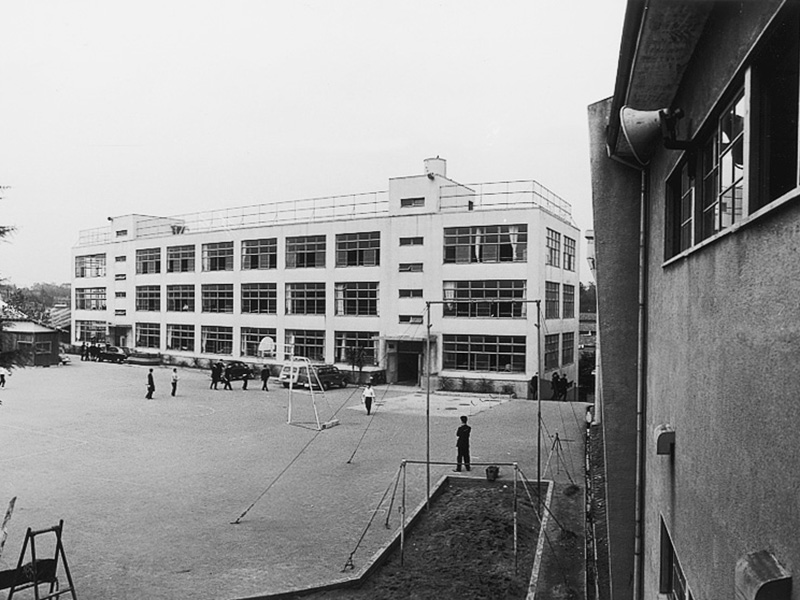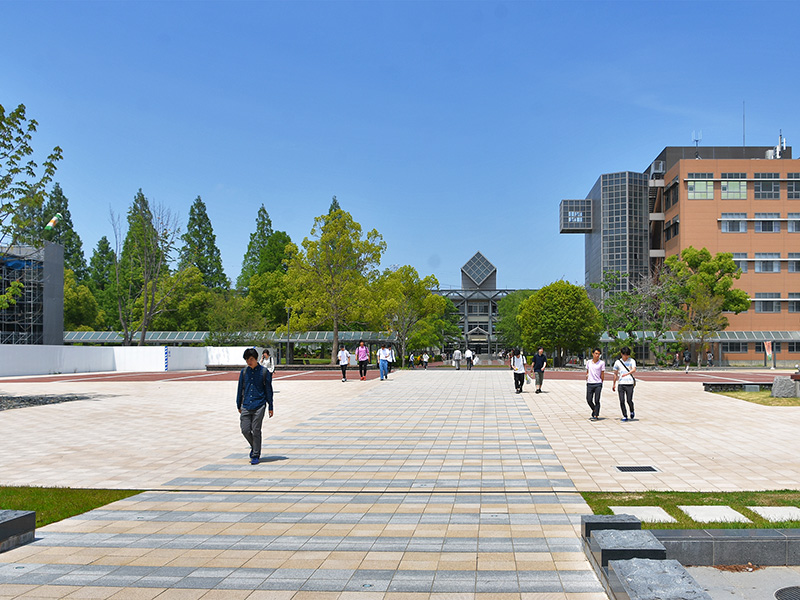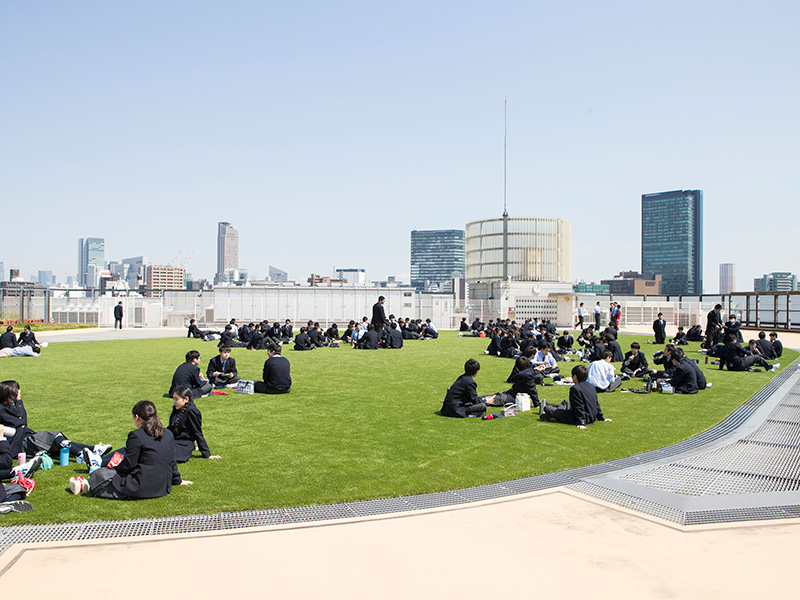Our History

School Building in 1913 ( Tokyo Engineering School)
The creation of a practical-learning school connected to the development of Japan’s first airplane
The time was May 1911 and the place was the Aoyama Parade Ground (now the Meiji Jingu Gaien). A mere seven years after the Wright brothers succeeded in the first human flight, Japan’s first aircraft was preparing to take to the skies.
A group of young people observed the scene with gleaming eyes and cheeks flushed with excitement. They were students at the newly founded Tokyo Engineering School, the forerunner to this school. The aircraft before them, which was the first of its kind in the country, had been assembled in the school’s training workshop under the guidance of Major Kumazō Hino, an authority in Japan’s aviation industry.
While the flight that day would unfortunately end in failure, it marked the beginning of a long tradition of focusing on practical education that gives rise to such technological advancements.

School Building No. 1 (Junior High)
Advancing Japan’s modernization by producing excellent engineers
Predecessor to the Nippon Institute of Technology, the Tokyo Engineering School received approval in 1907 and opened its doors the following year. Although Japan was barreling down the road toward modernization by way of the decree on industry promotion that followed the Meiji Restoration, there was a decided lack of technically skilled individuals. At the time, education was academic but not practical. Established to address both these problems, the Tokyo Engineering School was founded on the lofty ideal of providing young people with strong practical training in real-world environments.
Progress was not always smooth, however. As the eras changed from Meiji to Taishō and then to Shōwa, the school building was destroyed repeatedly by fire on five separate occasions. But each time, the school was unfalteringly resurrected to continue the advancement of Japan’s modernization by dispatching excellent graduates into the world. Under the new educational system that followed the Second World War, the school was reborn as the Tokyo Junior High School for Engineering and the Tokyo Technical High School. Although their names have changed with the times, our educational institutions still honor the ideals and traditions of their predecessors. Foremost among those is an emphasis on practical education brimming with honesty, optimism, and diligence as well as the youthful spirit of adventure.

Courtyard of the Main Building (University)
Establishing Japan’s first university for graduates of technical high schools
As the period of rapid economic growth drew near in the early 1960s, the industrial world needed people who could not only acquire skills but also develop the capacity for responding to new technology as it was introduced. Despite the fact that cultivating such individuals would require a university that accepted graduates of technical schools like Tokyo Technical High School throughout the country, there wasn’t a single university in Japan that offered entrance exams based on the coursework of technical high schools. “If that’s the case, we should just create one ourselves.” We wanted to expand our focus on practical learning through the collegiate level as well by creating a school system that encompassed junior high, high school, and university. Our sense of honesty, optimism, and diligence became the spark that ignited a youthful spirit of adventure.
After declaring our intention to build a university in 1961, we received ardent support from technical schools across the nation including the parents of students and the industrial world. Six years later, in 1967, we achieved our long-held dream by opening the Nippon Institute of Technology. Building the university was a decidedly homemade affair. The school building’s steel structural components and classroom fixtures along with about 3,800 sets of desks and chairs and 200 three-compartment lockers were all fabricated within the Komaba training workshop as part of the students’ practical learning. This was done because we did not want to waste a single yen of the precious donations received from parents and other donors and because we wanted to accomplish the objective ourselves.
It is a basic policy of our educational institution, which holds practical learning in the highest regard, to above all provide the best facilities so that students can learn about everything from handmade craftsmanship to cutting-edge manufacturing technologies. This approach of having the top facilities in the country carried over to the Nippon Institute of Technology as well. NIT is home to various advanced laboratories for experimental research; the Ultra-High-Voltage Research Center, which can produce man-made lightning; the Museum of Industrial Technology, where visitors can explore the history of industrial technology in Japan; and steam locomotives that are maintained in an operational state.
An era of new challenges
In 2018, Nippon Institute of Technology conducted an unprecedented reorganization of its faculties and departments. What had previously been a single department within the engineering faculty, was split into three faculties, six departments, and two sections: the Faculty of Fundamental Engineering consisting of the Department of Mechanical Engineering, the Department of Electrical, Electronics, and Communication Engineering, and the Department of Applied Chemistry; the Faculty of Advanced Engineering consisting of the Department of Robotics and the Department of Information Technology and Media Design; and the Department of Architecture, which contains two sections (Architecture and Living Design). As the knowledge and abilities of all students become more diversified, we are carrying on the tradition of practical engineering studies while undergoing an evolution that allows us to cultivate individuals capable of responding to future societal changes. Thus, the fundamental concept is “Heritage and Evolution.”
Nippon Institute of Technology’s Komaba Junior High and High School is leveraging that tradition while at the same time implementing changes that reflect the shifting societal needs of our time. The school was started after the war as a high school that only offered technical courses to boys; but in 2008, we established a new general education curriculum and opened enrollment to both boys and girls. Following that, we enhanced our approach to continuing education, including an integrated six-year path that starts in junior high. We are now accelerating our plan to implement the general-education curriculum throughout the entire school. We are in the process of carrying out the largest reorganization in its history.
Over 110 years have elapsed since our university was founded as the Tokyo Engineering School, and the society around it is entering a period of great transformation. Rather than mere knowledge and technical skills, a more substantial system of education and research is needed to impart the abilities that can make the best use of them, such as critical thinking, decision-making, taking initiative, and communication.
Moving forward, we will take up this “new challenge” by continuing to implement a variety of reforms while passing down the youthful spirit of adventure.

NIT Central Square

Rooftop of the NIT Junior High and High School
Our History
|
Date |
Event |
|---|---|
|
December 1907 |
Approval granted for the Tokyo Engineering School |
|
February 1908 |
Tokyo Engineering School opens (four subjects of electrical engineering, mechanical engineering, architecture, and mining and metallurgy) |
|
June 1930 |
Completion of Tokyo Engineering School’s five-story school building made of reinforced concrete |
|
June 1931 |
Tokyo Technical School is established with a five-year system (A-class) that allows graduates of elementary school to enroll |
|
March 1935 |
Tokyo Engineering School is renamed the Tokyo Technical High School |
|
October 1935 |
Corporate name is changed to the Tokyo Engineering Institute Incorporated Foundation |
|
April 1947 |
Tokyo Junior High School for Engineering established under the new school system |
|
April 1948 |
Tokyo Technical High School (the “High School”) established and relocated from Kanda to Komaba |
|
May 1948 |
Tokyo Technical High School established |
|
March 1951 |
Corporate name is changed to the Tokyo Engineering Institute Incorporated Educational Institution due to the Private Schools Act going into effect |
|
November 1958 |
50th-anniversary commemoration ceremony held |
|
December 1961 |
Akakura Sansō (a three-story building of reinforced concrete) completed in Myokokogen, Niigata Prefecture |
|
April 1967 |
Nippon Institute of Technology (the “University”) opens |
|
November 1968 |
60th-anniversary commemoration ceremony held for the institute |
|
January 1973 |
Kanji Asada begins serving as the Tokyo Engineering Institute’s second chairperson of the board |
|
March 1974 |
Part-time enrollment suspended at the High School |
|
April 1975 |
Information Engineering Department created within the University’s Engineering Faculty |
|
November 1977 |
70th-anniversary commemoration ceremony held for the Tokyo Engineering Institute Incorporated Educational Institution |
|
July 1980 |
Munehide Kubota begins serving as the Tokyo Engineering Institute’s third chairperson of the board |
|
April 1982 |
Master’s courses established at the NIT Graduate School |
|
April 1987 |
Doctorate courses established at the NIT Graduate School |
|
June 1987 |
80th-anniversary commemoration ceremony held for the Tokyo Engineering Institute Incorporated Educational Institution |
| September 1987 |
University Museum of Industrial Technology opens |
|
April 1990 |
Name changed from Tokyo Engineering Institute Incorporated Educational Institution to Nippon Institute of Technology Incorporated Educational Institution |
|
March 1991 |
Kiyoyasu Ōkawa begins serving as the NIT Incorporated Educational Institution’s fourth chairperson of the board |
|
April 1995 |
Systems Engineering Department created within the University’s Engineering Faculty |
|
June 2001 |
University obtains the ISO 14001 certification for environmental management |
|
March 2002 |
Completion ceremony held for a new building at the High School |
|
April 2005 |
Graduate course in technology management created at NIT’s Graduate School of Management of Technology |
|
June 2007 |
100th-anniversary commemoration ceremony held for the NIT Incorporated Educational Institution |
|
April 2008 |
Junior High attached to the Nippon Institute of Technology and Tokyo Technical High School attached to the Nippon Institute of Technology are renamed the NIT Komaba Junior High School and NIT Komaba High School, respectively |
|
April 2009 |
Products Engineering and Environmental Management Department and Living Design Department are created at the University |
|
July 2013 |
Akira Yanagisawa begins serving as the NIT Incorporated Educational Institution’s fifth chairperson of the board |
|
September 2017 |
Large-scale renovation of Junior High building completed (construction project commemorating the institute’s 110th anniversary) |
|
December 2017 |
Renovation of Akakura Sansō completed (construction project commemorating the institute’s 110th anniversary) |
|
March 2018 |
University dining hall, student club building, and kitchen & Café Trevi completed (construction project commemorating the institute’s 110th anniversary) |
|
April 2018 |
University’s Engineering Faculty reorganized into three faculties and six departments |
|
June 2018 |
50th-anniversary commemoration ceremony and celebration held for the University |
|
December 2018 |
University’s multi-purpose lecture hall completed (construction project commemorating the institute’s 110th anniversary) |
|
July 2019 |
University’s applied chemistry building completed |
|
April 2020 |
Komaba High School transitioned to a general course school |
|
April 2022 |
The Faculty of Advanced Engineering has established a Data Science Department. |